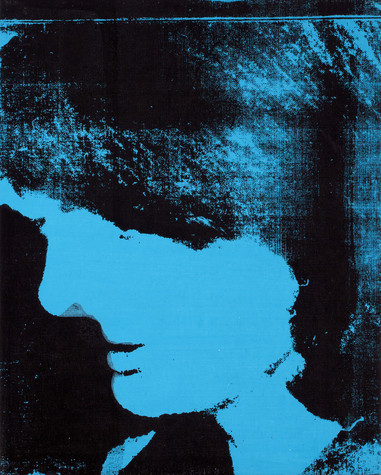The following assessments can be used for this lesson using the downloadable assessment rubric.
- Communication 1
- Communication 2
- Critical thinking 1
- Critical thinking 2
- Historical context 1
- Historical context 2
- Historical context 4

Andy Warhol, Jackie, 1964
The Andy Warhol Museum, Pittsburgh; Founding Collection, Contribution The Andy Warhol Foundation for the Visual Arts, Inc.
© The Andy Warhol Foundation for the Visual Arts, Inc.
1998.1.84
America experienced change throughout the early 1960s, from the civil rights movement to space exploration. John F. Kennedy’s short presidency from 1961 until his shocking death by assassination on November 22, 1963, set the tone for the remainder of the decade. The youngest president ever elected in the United States, JFK and his wife, Jackie, quickly became American icons, not just for JFK’s progressive policies, but also for their youth, glamour, and style.
Deeply affected by JFK’s assassination, Warhol began a large portrait series of his widow, Jackie. Based on images from magazines and newspapers, these portraits were shown individually and in groups. Warhol’s isolation and repetition of Jackie’s image suggest both the solitary and collective experience of the widow and the nation witnessing the tragedy. Commentators have remarked that television became a unifying force during this time as people obsessively watched the events unfold in Dallas and at the funeral throughout the following week. Warhol’s multiple images offer the viewer an obsessive reenactment of this event in American history. Even later in his life Warhol was amazed at the power Jackie’s image held as a reminder of the assassination: “As we walked through the galleries every person recognized Jackie. They didn’t come too close. They stopped for a minute, looked, and whispered. You could hear her name in the air: ‘Jackie. Jackie.’ It’s a very strange feeling. There is so much awe and respect for her. Being with her is like walking with a saint.” ( Andy Warhol’s Exposures 1980)
When President Kennedy was shot that fall, I heard the news over the radio while I was alone painting in my studio…. I’d been thrilled having Kennedy as president; he was handsome, young, smart—but it didn’t bother me that much that he was dead. What bothered me was the way the television and radio were programming everybody to feel so sad…. It seemed like no matter how hard you tried, you couldn’t get away from the thing.
Andy Warhol, POPism: The Warhol Sixties, 1980
Well, Kennedy was sort of this savior, this prince, and they called his administration Camelot. And when he died it seemed that he took the dreams—I was 13—the dreams of the future generations were shattered when he was killed…. I’ve never looked at government and politics in quite the same way after that. I no longer think that our elected officials are competent.
Interview with New York woman,
Roy Rosenzweig and David Thelen, The Presence of the Past: Popular Uses of History in American Life, 1998
Her face is as familiar to me as that of my mother. As a small child I even associated Jacqueline Kennedy with Mom: poised and elegant, with the same thick dark hair, tailored suits, pillbox hats and white gloves. But here, Jackie seems less a maternal object than a religious icon. The thirty-two jewel-colored squares look like a wall of stained glass. Do the images reveal the gracious First Lady or the stunned widow? The photos seem to tell both stories. Do the multiple images enable us to empathize with Jackie, or do they destroy her uniqueness by making her a commodity? If she has become a brand-name product, like Warhol’s Campbell’s Soup Cans and Marilyns, can we ever recover the “real” Jackie? And what are we, as insatiable consumers of gossip about her and the Kennedy family?
Paula Kane, Point of View Labeling Project, The Andy Warhol Museum, 2001
Warhol rendered Jackie—celebrity/victim—in his standard grid, repeating images as if they were mug shots, frames of documentary film footage, or a fan’s clippings. Repetition implies mourning: the Dallas scene is a trauma, and mourning takes the form of recycling and recall, a process that unsettles chronology…. Repetition implies commodification: Jackie no longer has control over her own image…. Repetition implies obsession: the Jackie photos are cropped—narrowing the focus onto Jackie alone, myopically isolating her from context…. A narrative emerges, and it is not the story of Jackie’s life or the growth of Jackie’s soul—but the narrative of the image and of our relation to the image.
Wayne Koestenbaum, Jackie Under My Skin: Interpreting an Icon, 1995
In a class critique, students read their artist statements and discuss their finished projects, their decision-making processes, and the effect repetition has in each work.
Possible discussion questions:
The following assessments can be used for this lesson using the downloadable assessment rubric.